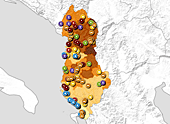The Health Ministry distributed seven of the hydro-claves to hospitals and other medical institutions around the country as part of a government-run Health Sector Modernization Project, supported by the World Bank.
At Tirana’s public University Hospital Center, named for famous Albanian, Mother Teresa, medical waste often exceeds 800 kilograms a day.
Until recently, the waste was burned by hospital employees, like Sotir Gjermeni, at this now-defunct incinerator on hospital grounds, causing terrible smoke and terrible smells.
“There was extreme pollution around the area and for hundreds of meters, and the residents complained,” Gjermeni said.
The health project has since provided the Hospital Center with a hydro-clave, and trained Sotir and other employees how to use it.
They work in shifts sterilizing the medical waste and bagging it for safe disposal afterwards at municipality landfills. They also sterilize waste for other medical institutions that don’t have their own hydro-claves, said Hospital Technician, Latif Gurthi, as he shoveled piles of incoming used syringes, empty bags from the hospital’s blood bank, and old bandages into the hydro-clave.
“First, they bring here the waste from different hospitals, we check it, weigh it, and separate it. And then we sign off on it, and so do the people bringing it,” Gurthi said.
Hospital staff and residents living near the inoperative incinerators say the cleaner and safer process for eliminating medical waste has led to a cleaner and safer environment.
At a small café and restaurant which sits directly across from the University Hospital Center’s incinerator, 86-year-old Bardhyl Kadesha was just finishing having coffee with a friend.
“For the area around the hospital, the climate was harmed due to smoke and the smell,” he said of the days before the arrival of the neighboring hospital’s hydro-clave, and consequent closing of the incinerator.
He no longer got the sore throats he used to, said Kadesha, adding that he and the entire neighborhood were breathing better for the first time in many years.

